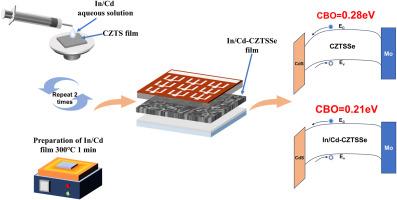优化带向的协同In/Cd共掺杂策略实现了10.23%的无zno Cu2ZnSn(S,Se)4太阳能电池效率
IF 6.3
2区 材料科学
Q2 ENERGY & FUELS
引用次数: 0
摘要
在没有ZnO窗口层的新型CZTSSe太阳能电池中,Cu2ZnSn(S,Se)4 (CZTSSe)/CdS(In)的能带排列已经在我们之前的研究中进行了初步的研究。然而,扩散到吸收器内的CdS(In)的In含量较低,对能带排列的调节能力有限。在这项工作中,我们使用了掺杂离子的吸收剂来调节缺陷。然而,这种方法会导致短路电流密度(Jsc)的显著损失。为了解决这一问题,引入Cd通过促进晶粒生长和改善形貌来增强Jsc,从而抵消掺杂In导致的Jsc损失。In和Cd的共掺杂将导带偏置(CBO)从0.28 eV降低到0.21 eV,从而抑制载流子复合,提高输运效率。此外,本体缺陷的浓度降低了一个数量级。结果表明,填充系数(FF)从56.97%提高到60.08%,Jsc从37.10 mA/cm2提高到38.66 mA/cm2,开路电压(Voc)从431.64 mV提高到440.48 mV。最后,将CZTSSe太阳能电池的功率转换效率(PCE)提高到10.23%。本文章由计算机程序翻译,如有差异,请以英文原文为准。

Synergistic In/Cd Co-doping strategy for optimizing band alignment achieves 10.23 % efficient ZnO-free Cu2ZnSn(S,Se)4 solar cells
The band alignment of Cu2ZnSn(S,Se)4 (CZTSSe)/CdS(In) in novel CZTSSe solar cells without a ZnO window layer has been initially investigated in our previous studies. However, the In content of CdS(In) diffused into the absorber is low, and the ability to regulate the band arrangement is limited. In this work, we employ In-ion-doped absorbers to adjust defects. However, this approach leads to a significant loss in short-circuit current density (Jsc). To address this, Cd is introduced to enhance Jsc through grain growth promotion and morphological improvement, thereby offsetting the Jsc loss induced by In doping. The co-doping of In and Cd reduces the conduction band offset (CBO) from 0.28 eV to 0.21 eV, thereby inhibiting carrier recombination and enhancing transport efficiency. Additionally, the concentration of bulk defects is reduced by an order of magnitude. As a result, the fill factor (FF) increased from 56.97 % to 60.08 %, Jsc increased from 37.10 mA/cm2 to 38.66 mA/cm2, and open-circuit voltage (Voc) increased from 431.64 mV to 440.48 mV. Finally, the power conversion efficiency (PCE) of CZTSSe solar cell is enhanced to 10.23 %.
求助全文
通过发布文献求助,成功后即可免费获取论文全文。
去求助
来源期刊

Solar Energy Materials and Solar Cells
工程技术-材料科学:综合
CiteScore
12.60
自引率
11.60%
发文量
513
审稿时长
47 days
期刊介绍:
Solar Energy Materials & Solar Cells is intended as a vehicle for the dissemination of research results on materials science and technology related to photovoltaic, photothermal and photoelectrochemical solar energy conversion. Materials science is taken in the broadest possible sense and encompasses physics, chemistry, optics, materials fabrication and analysis for all types of materials.
 求助内容:
求助内容: 应助结果提醒方式:
应助结果提醒方式:


